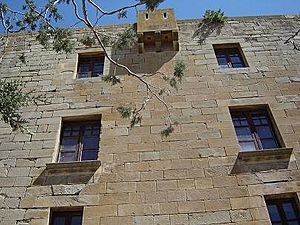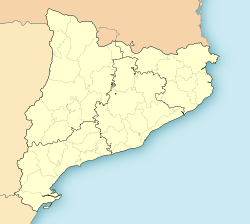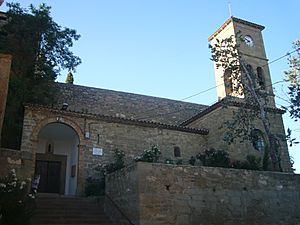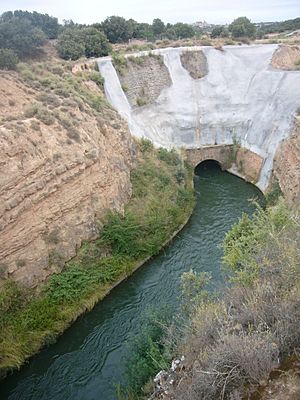Montclar d'Urgell facts for kids
Quick facts for kids
Montclar d'Urgell
|
|
|---|---|
|
village
|
|
 |
|
| Country | |
| Community | |
| Province | Lleida |
| Comarca | Urgell |
| Area | |
| • Total | 9.50 km2 (3.67 sq mi) |
| Elevation | 470 m (1,540 ft) |
| Population
(2022)
|
|
| • Total | 90 |
| • Density | 9.5/km2 (24.5/sq mi) |
| Demonym(s) | Montclarí, montclarina |
| Time zone | UTC+1 (CET) |
| • Summer (DST) | UTC+2 (CEST) |
Montclar d'Urgell is a small village in the Lleida province of Catalonia, Spain. It's a unique place because it's an exclave of Agramunt. This means it's a part of Agramunt but not directly connected to it. Montclar d'Urgell is also an exclave of the Urgell region, even though it lies within the Noguera region.
The village sits on top of the Montclar mountain range, which stretches from east to west. The Urgell Canal even passes through this mountain range using a special tunnel. You can reach Montclar by road, as it's connected to the local C-14 road between Artesa de Segre and Agramunt. As of 2022, about 90 people live in Montclar d'Urgell.
Contents
Exploring Montclar d'Urgell
Montclar Castle: A Historic Landmark
The impressive Montclar Castle stands proudly over the village. This castle was built on the remains of an old Roman tower. Records show the castle existed as early as the year 981, making it the oldest in the area! You can still see parts of the Roman tower wall inside.
Most of the castle's first floor was built in the 1200s. The upper floors were later updated after the Christian Reconquest, showing beautiful Catalan Renaissance style from the 1500s and 1600s. The castle was fixed up in 1970 and became a national historic monument in 1979. Today, you can visit it!
Only six families have owned Montclar Castle since the Christian Reconquest:
- The Tost family (until 1067)
- The Cabrera family (1067-1179)
- The Ribelles family (1179-1418)
- The Pons family (1418-1689)
- The Despujol family (1689-1986)
- The Miguel family (1986 to today)
Church of St. James: A Unique Design
The Church of St. James is the main church for the village. It was built in the 1600s in the Baroque style. The building is made of stone and has six altars inside.
One special thing about this church is its two choir lofts. Unlike most churches where they are side-by-side, here they are placed one above the other! The upper choir loft could only be reached from the castle. This allowed nobles to attend Mass without mixing with other villagers. Mass is still held here every Sunday.
Montclar Mine: An Amazing Tunnel
Deep underground, about 160 meters below the village, the Urgell Canal passes through the Montclar mountain range. It does this by going through an amazing tunnel called the Montclar Mine. This tunnel is completely straight and is 4,917 meters long, 5.15 meters wide, and 5.47 meters high.
Building the mine started in November 1853 and finished in November 1861. It took 150 animals and over 6,000 people to complete this huge project. This included architects, masons, and many laborers. Sadly, hundreds of workers died during construction and were buried in a large grave in Montclar's cemetery. To make the work easier, 13 wells were dug from the mountain surface down to the tunnel level. All the digging was done by hand, and over 500 trucks of excavated rock were removed. For almost a century, this was the longest tunnel and hydraulic work in Europe! You can even hike inside the tunnel during winter.
Culture and Traditions
Folklore: Ghosts and Wild Boars
Montclar d'Urgell has some fun folklore:
- The Fantasma Jaumet is a giant ghost figure built in 2011. It's made of wood, stands 3 meters tall, and is 2.5 meters wide. This giant ghost leads the first dance at the Saint James festival, which is the most important festival in the village. In 2012, they even added a tongue and cardboard eyes to it! People in Montclar have always told stories about ghosts and witches, especially because of the old castle. This led to the creation of the giant ghost, named Jaumet in honor of Saint James, the village's patron saint.
- The Massaporc is a giant wild boar figure from Montclar d'Urgell. It was built in 2013 with a wooden frame and covered in cardboard. Wild boars are common animals found in the Montclar mountain range.
Local Festivals: Celebrating Together
Montclar d'Urgell celebrates several local festivals throughout the year:
- Saint Sebastian (January 20): Villagers celebrate this day to thank Saint Sebastian for curing the village of the plague long ago. This festival is still held today.
- Saint Vicente (January 22): In the past, if this day was sunny, the people of Montclar would keep an oil lamp burning all year in the skull of Saint Vincent, located in the Church of St. James. Everyone in the village would donate oil to keep it lit. If the day was foggy, the lamp would not be lit for the whole year.
- Saint Mark (April 25): On the Sunday after this date, everyone walks in a procession to the Salgar shrine, which is 8 kilometers from Montclar. In the past, the mayor and town council members led the procession, and no one was allowed to speak until they reached the shrine.
- Saint James (July 25): This is the most important festival, dedicated to the patron saint of the church. The festival takes place on the closest weekend to July 25. It's one of the busiest festivals in the province, featuring performances by popular music groups.
Famous People from Montclar
Montclar d'Urgell has been home to some notable people:
- Josep de Pons i de Guimerá (1625 - 1690): Known as General Montclar, he was a general in the French army. He fought in important wars like the Franco-Dutch War and the Nine Years' War.
- Josep Alsina i Casas (1907 - 1936): Known as Agustine of Montclar, he was a Capuchin friar, a philosopher, and a poet. He is honored as a saint by the Catholic Church.
See also
 In Spanish: Montclar de Urgel para niños
In Spanish: Montclar de Urgel para niños







